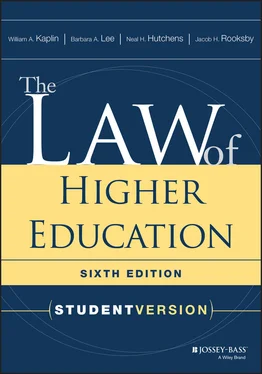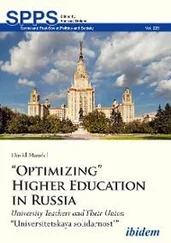3.2.2.3 Liability for injuries related to on-campus instruction.Students or other invitees injured while involved in on-campus instructional activities may file negligence claims against the institution, the instructor, or both. For example, in McDonald v. University of West Virginia Board of Trustees , 444 S.E.2d 57 (W. Va. 1994), a student enrolled in a theater course sued the university for negligence, seeking damages for a broken leg and ankle. The professor was teaching a class in “stage movement” and had taken the class outdoors, where the students were asked to run across a lawn simulating fear. Several students performed the exercise before the plaintiff took her turn. As she was running, she encountered a small depression in the lawn, stumbled and fell, and was injured.
Although the jury had found for the plaintiff, the trial judge had entered judgment for the university, which the Supreme Court of West Virginia affirmed. The student had sought to demonstrate that the professor's supervision of the class was negligent, but the court disagreed. The professor had inspected the lawn area before the class and had not noticed the small depression. Furthermore, evidence showed that theater students at the university were given safety instructions and that the professor had discussed safety issues in that class. The syllabus included information on safety, including what clothing to wear, layering of clothing, and body positioning. The faculty member required students to wear high-top tennis shoes as a further safety precaution. The faculty member was present at the time of the student's injury, and the court found that no amount of supervision or scrutiny would have discovered the “small depression” that caused the student to fall. Therefore, said the court, the faculty member's actions were not a proximate cause of the injury, and the university itself was not required to maintain a lawn completely free of “small depressions.”
This case is notable because of the relatively high level of caution apparently displayed by the faculty member. Clearly, the safety instructions (which, since they were on the course syllabus, were easily proven) and the faculty member's statement that she inspected the lawn area prior to the class were important to the defense of this lawsuit. A similar degree of care could not be demonstrated in another case in New York, and this difference appears to have caused a very different result. In Loder v. State of New York , 607 N.Y.S.2d 151 (N.Y. App. Div. 1994), Alda Loder was enrolled in an equine studies course at the State University of New York at Cobleskill. It was her first such course. Each student was required to perform two weeks of “barn duty,” which included grooming a horse assigned to the student. When Ms. Loder approached the stall of the mare to which she was assigned and attempted to enter the stall, the mare kicked her in the face, causing serious injuries. The student sued, alleging that the university was negligent both in the way that the horse was tethered in the stall and in its failure to properly instruct the student with respect to how to enter the stall of a fractious horse.
The trial court had found the university 60 percent liable for the student's injury. The university appealed, but the appellate court sided with the student. First, said the appellate court, there was sufficient evidence of the horse's propensity to kick to suggest that the university was negligent in its method of tethering the horse. Furthermore, there were no written instructions on how to enter the horse's stall. The university employee who had shown the student how to enter the stall had used the incorrect procedure, according to an expert witness called by the university. Therefore, the court concluded, although the owner of a domestic animal normally is not responsible for injuries caused by that animal unless the animal is known to be “abnormally dangerous,” in these circumstances, the university was negligent both in failing to instruct the student regarding safety and in the method used to secure the horse.
The student in Loder was a beginning student, and her lack of familiarity or experience with horses was a significant factor. If a student is experienced, however, a court may be less sympathetic. In Niles v. Board of Regents of the University System of Georgia , 473 S.E.2d 173 (Ga. Ct. App. 1996), the plaintiff, a doctoral student in physics at Georgia Tech, was injured in a laboratory accident. The student had been working in the laboratory on a project related to a course in superconducting crystals and had been cleaning some equipment with a mixture of acetone, ethanol, and nitric acid, a highly explosive combination. A more senior doctoral student had suggested that “recipe” as a cleaning solution. Following the accident, the student asserted that the university, through his professor, was negligent in its failure to instruct him that this combination of substances was volatile.
The court was not sympathetic to the student's claim that he needed instruction. He had graduated summa cum laude with a major in chemistry and had obtained a master's degree in physics with a 4.0 average. He had spent “hundreds of hours” in laboratories, according to the court, and had previously worked with all three of the substances. Therefore, said the court, the professor had the right to assume that the student either would know of the dangers of these substances or would “perform the research necessary to determine those dangers and take the necessary precautions” (473 S.E.2d at 175). Therefore, the faculty member had no duty to warn the student about the dangers of mixing “common chemicals,” said the court. (For a similar case with the same result, see Fu v. University of Nebraska , 643 N.W.2d 659 (Neb. 2002).)
The defense of “assumption of risk” is routinely used against negligence claims, as a defendant argues that a plaintiff was fully aware of the risks of a particular course of action so that the defendant had no duty to warn the plaintiff of those dangers. In cases involving classroom instruction, however, this defense may have limited success. For example, in Drogaris v. Trustees of Columbia University , 743 N.Y.S.2d 115 (N.Y. App. Div., 2d Dept. 2002), the court denied a university's motion for summary judgment in a case in which a student enrolled in a graduate course in kinesiology (the study of movement) was injured after the course instructor used her for a physical demonstration of a clinical test. The student alleged that the instructor hyperextended her leg, resulting in a muscle tear. The court rejected the university's argument that the student assumed the risk of injury by participating in the class.
If the equipment that a college or university provides for a student's use is defective or incorrectly assembled and the student is injured as a result of an otherwise proper use of the equipment, it is likely that a court will find the school liable for negligence, even if it is in a state with a tort claims act. See, for example, Texas State Technical College v. Beavers , 218 S.W.3d 258 (Tex. App. 2007). And if an instructor allows a student to engage in potentially dangerous activities (here, welding metal with a torch) without supervision or proper protective clothing, the university may be held responsible for the student's injuries ( Lei v. City University of New York , 823 N.Y.S.2d 129 (N.Y. App. Div. 2006)).
In physical injury claims related to classroom activities, courts seemingly will consider a student's knowledge level. If the student is a novice, as in Loder , Lei , Beavers , and Drogaris , there is likely to be a duty to instruct and supervise. If the student is experienced, however, and has knowledge that is similar to the knowledge of the professor, then the court may not find a duty to supervise or instruct. And, of course, the more an institution can demonstrate that safety precautions and safety training were carried out, the more likely the institution is to prevail.
Читать дальше












